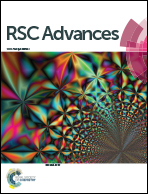Electro-catalysis of carbon black or titanium sub-oxide supported Pd–Gd towards formic acid electro-oxidation
Abstract
Carbon black supported Pd–Gd catalysts (Pd–xGd/C, x is weight percent in catalyst) with different amounts of Gd were prepared by a simultaneous reduction reaction with sodium borohydride in aqueous solution. The structure, morphology and element valence state of these catalysts were characterized by X-ray diffraction (XRD), transmission electron microscopy (TEM) and X-ray photoelectron spectroscopy (XPS), respectively. The electro-catalytic performance of these catalysts for formic acid oxidation was investigated using cyclic voltammetry (CV), chronoamperometry (CA) and CO stripping experiments. It is found that the Pd–2.5Gd/C catalyst has a better electro-catalytic activity than the Pd/C catalyst, which can be explained by a bi-functional mechanism. In addition, the higher content of metallic Pd caused by the addition of Gd also contributes to the better catalytic activity of Pd–2.5Gd/C. Based on the good electro-catalytic performance of the Pd–2.5Gd/C, Pd–xGd/Ti4O7 (x stands for weight percentage in whole catalyst) catalysts were also prepared and characterized in the same way. The Pd–2.5Gd/Ti4O7 and Pd–4Gd/Ti4O7 catalysts exhibited better catalytic activities than the Pd–2.5Gd/C catalyst, which mainly results from the further increase of metallic Pd caused by Ti4O7.


 Please wait while we load your content...
Please wait while we load your content...